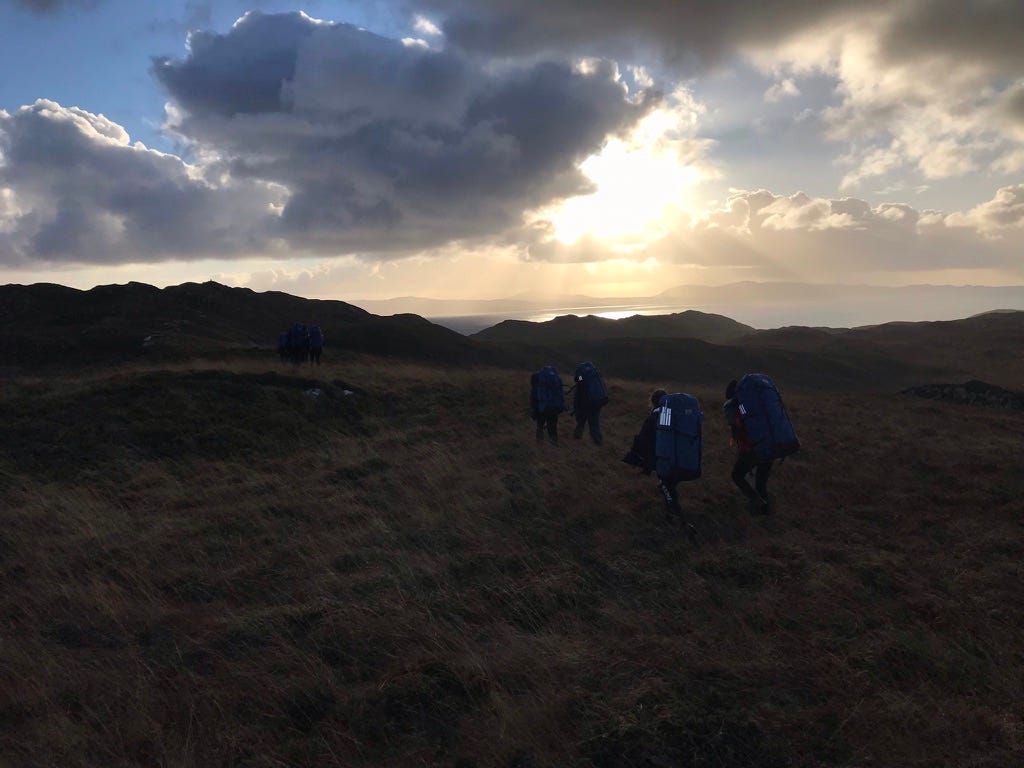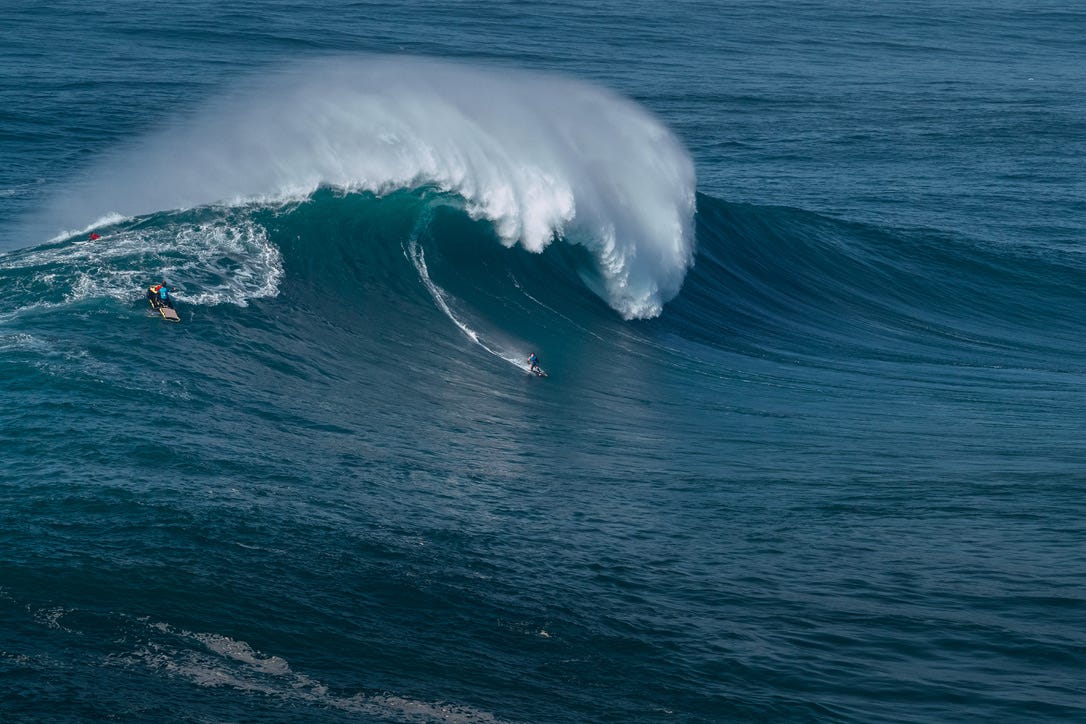Greetings from a tent at a beach somewhere on the wild west coast. I’d like to pretend I’m here on some kind of fantastic solo adventure, but outside my tent there’s a group of 13 year olds playing Spin the Bottle. It’s an interesting juxtaposition to the rugged, elemental setting.
To be fair to them, it’s bloody freezing, and I’m frankly amazed they’ve still got the energy, given they hiked in over hill and bog carrying packs bigger than themselves in 30mph winds. I’m also impressed that none of them have spewed (yet) from the mussels they cooked and ate off the rocks. And they even asked if I wanted to join in with Spin the Bottle when I checked on them (not that I can’t hear every single word given they’re about 20ft away), but I politely declined.
Apparently someone had already kissed a rock. It was getting pretty crazy.
I’m not sure I could recommend camping in November. It’s half past 8 and it’s been dark for nearly 5 hours. It’s a bit like 7am at a festival, except instead of generic campsite techno it’s kids kissing rocks.
What has any of this got to do with running, you may ask. Well, you may ask, and I will tell you not very much, but it’s my newsletter and I am writing it on my phone in a tent, and sometimes it will veer into the realms of personal diary and you will like it or not!
But it’s also got me thinking about adventure and travelling light. Two things that hold the greatest appeal for me in terms of running.
I’m an over-preparer.1 I always take more gear than necessary and pace around the house and back and forth to the shed, preparing and packing and re-preparing and packing and checking then checking again. I swither over arbitrary shoe, clothing, board or snack choices, and I hate, hate, hate it.
It’s indecisive agony. I loathe choices and making decisions. Running, for the most part, helps to quieten that particularly annoying quirk of my nature.
With running, you’re forced to be light, and the lightness is felt not just in physical weight, but in manner and attitude.
If you want me to agree to something I might not otherwise agree with, catch me after a run. If you want to talk about something requiring choices or any depth of thought, catch me after a run.
In preparation for coming here we had to kit the kids out with tents and waterproofs and sleeping and cooking gear. It was bulky, heavy, and it made me grateful (and a little guilty) for my own lightweight gear.
But, well, they have to learn.
And it got me thinking about the multi-day running adventures I’d like to do, and what sort of things are absolutely necessary to keep warm, dry and fed whilst still retaining the ability to actually run. Packing light for hiking is easy, for running not so much. Bulk is a hinderance as much as weight.
(You could be like Rosie Swale-Pope and her cart, of course, but we could all be a little more like her in general).
The king of lightweight but essential gear is the bivy bag.2 Mine came from an army surplus store, is made of Gore-Tex and was cheap.3 It isn’t the lightest, or the most packable, but it’s good enough, and is infinitely better than any tent.
Food is always an issue. It’s hard to find the balance of calories, weight / bulkiness and perishability.4 I still don’t have the solutions to this, but enjoy picking up tips. A couple of good ones: you know those instant porridge sachets? Pour hot water straight into the packet, therefore negating the need for a bowl. They don’t look waterproof, but they are. (Thanks, Liam). Or try instant soup packets as flavouring for couscous (which has the added benefit of cooking quickly, saving time and gas). (Thanks, Steve).
Answers on a postcard for more!
(Obviously there’s dehydrated ration packs, too, but I’m a middling runner looking for a wee adventure, not a spaceman).
Let me share with you a little dream I have about a future running journey…
In ye days of old5, Highland men were tasked with driving cattle from the north of Scotland to the markets in the south. This took place every autumn for hundreds of years.
Shelter was provided by natural features of the landscape or hospitality from people along the way. Food was a mix of basic staples they could carry, like potatoes and oats, or what they might catch, like trout from the burns. Apparently drovers would also bleed their cattle, mixing the blood with oats and onion to make a kind of black pudding.
It was an unglamourous task to trek cattle through rough and mountainous Highland terrain, but it suited the tenants who not only performed this role in lieu of rent to their landlords, but also probably relished the hardship and excitement that was missing from their lives in the years following the dissolution of the clans.6
Some of the routes have faded from both landscape and memory, and some have been repurposed or tarred. But enough remain that you might re-create these journeys, given the inclination.
There’s a famous route stretching 200 miles from Glenbrittle on Skye to the market at Crieff in Perthshire. To cross to the mainland the cattle were made to swim across the narrows at Kylerhea. This is the journey I’d like to do.
I’ve a romantic notion of doing it with a bare bones approach to make it as authentic as possible - swimming the narrows, taking basic rations and clothing, no mobile phone etc - but we’ll see how brave I’m feeling, especially if I do it alone…
But for now I’ll just need to be content with driving 13 year olds across the moor in the wind and rain tomorrow morning. Tired 13 year olds who’ve been winching rocks all night, likely no more or less stubborn or communicative than cattle.
If I’m honest, though, these 10 kids, only 4 of whom I’ve taught and knew beforehand, have done a lot to restore my faith in humanity. They’re a diverse group, not natural friends outside this context, but they all got along great without excluding anyone. Many of them have never camped before, or done anything remotely like this. They supported each other, entertained each other, and smiled throughout. There were zero moans, despite the tough conditions. And despite the lack of phone signal, long hours of darkness and freezing cold, none were eager to retire quietly to their tents.7
Teaching can make you feel a little disillusioned sometimes, mainly because of how passive some kids can be. Sometimes it feels like there’s not only unwillingness to think and act for themselves, but inability. It’s not their fault, of course, they’re conditioned that way. So it’s great to see that when you strip things back, take them out of their element and replace some of the things that hold them back with fundamentals like sorting food and shelter for themselves, that they not only cope, but thrive.
In keeping with my sense of restored faith in the yoofs of today, (and if you’ll permit me some cross promotion) I spoke to Ben Larg this week, the Tiree teenager who’s making some noise in big waves, and wrote a piece about it for Beachgrit. (Ignore the algorithmically guided headline). He seems like a great kid and a rare light for Scottish surfing.
So go lightly, take some chances, and whether the future pans out like you imagine or not, the hope it might can still be bright.
In some ways, mainly to do with travel and hobbies. Melanie marvels at my ability to ghost out of the house at 4am to go surfing, but drag my heels on an average work day.
Why do some people spell “bivy” with a double “v”?
Somewhere in the region of £20-£30, I can’t quite remember. It also has a couple of orangey marks on the inside which may or may not be bloodstains, but doesn’t affect its capacity to keep me warm and dry.
I’m not sure this is a word.
From the 15th-19th centuries, if we’re being specific.
Perhaps a greater danger than the elements came from being attacked by cattle thieves, which was a regular and expected occurrence.
They may or may not have been on the beach at 0130!






Best one yet. Especially the part about the cattle drovers.